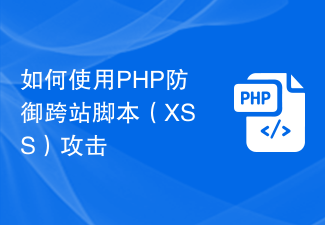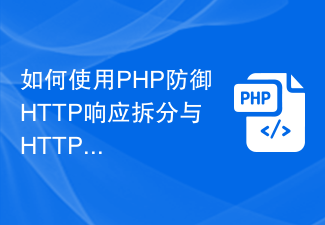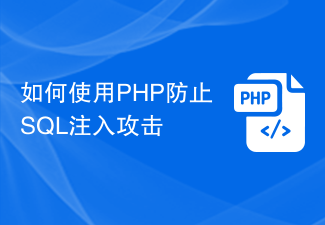With the development of the Internet and the popularization of applications, clickjacking attacks are appearing more and more frequently, becoming one of the main issues affecting Internet security. PHP is a commonly used Internet development language. How to prevent clickjacking attacks in the development of PHP language?
Clickjacking attack means that the attacker embeds malicious code to trick the user into secretly clicking on a suspicious link without being seen, and then obtains the user's private information and other sensitive information. In order to prevent this kind of attack, the following measures can be taken in application development:
- Prohibit page framing
Page framing means embedding the attacked page into In the frame of a third-party site, users cannot tell the source of the frame at this time, and may be subject to phishing attacks at worst, or lose private information at worst. Developers can disable page framing by adding X-FRAME-OPTIONS to the HTTP response header. X-FRAME-OPTIONS is an extension of the HTTP response header that sets options that prevent third-party sites from embedding application pages via iframes. In the PHP code, the code to prohibit page framing is as follows:
header('X-Frame-Options:SAMEORIGIN');
In the above code, the X-FRAME-OPTIONS header is set The SAMESITE means that page framing is only allowed under the same site.
- Add random verification
Generate random verification tokens for users when performing user operations, so that attackers cannot simulate the user's operations under unknown circumstances. own attack purpose. In PHP, you can generate a token by using session. The sample code is as follows:
session_start();
$_SESSION['token'] = md5(time());
echo "Token value :".$_SESSION['token'];
In the above code, use session to set a randomly generated token and then pass it to the front-end page. When the user performs an operation, the token value needs to be submitted together, and the background determines whether the token is valid and matching. Once it is submitted repeatedly or expires, it can be intercepted immediately.
- Detecting Referrer information
Attackers use Referrer hijacking to connect resources on the website to conduct illegal activities. Therefore, defense based on Referrer information is also a relatively effective method. In PHP, you can obtain the current referer information through $_SERVER[‘HTTP_REFERRER’] and compare it with the referer of normal requests. When the referer information is inconsistent with the request source, it can be judged as an illegal request and refused to be processed. The sample code is as follows:
if($_SERVER['HTTP_REFERRER'] != 'http://www.example.com'){
die(‘非法访问’);
}
In short, For PHP language application development, security is one of the factors that must be considered. Developers can effectively prevent clickjacking attacks by limiting page framing, adding random verification, and detecting referrer information.
The above is the detailed content of How to prevent clickjacking attacks in PHP language development?. For more information, please follow other related articles on the PHP Chinese website!
 php怎么设置implode没有分隔符Apr 18, 2022 pm 05:39 PM
php怎么设置implode没有分隔符Apr 18, 2022 pm 05:39 PM在PHP中,可以利用implode()函数的第一个参数来设置没有分隔符,该函数的第一个参数用于规定数组元素之间放置的内容,默认是空字符串,也可将第一个参数设置为空,语法为“implode(数组)”或者“implode("",数组)”。
 PHP如何防止SSTI攻击?Jun 30, 2023 am 09:36 AM
PHP如何防止SSTI攻击?Jun 30, 2023 am 09:36 AM如何使用PHP防御Server-SideTemplateInjection(SSTI)攻击引言:Server-SideTemplateInjection(SSTI)是一种常见的Web应用程序安全漏洞,攻击者通过在模板引擎中注入恶意代码,可以导致服务器执行任意代码,从而造成严重的安全隐患。在PHP应用程序中,当不正确地处理用户输入时,可能会暴露出SST
 如何使用PHP防御跨站脚本(XSS)攻击Jun 29, 2023 am 10:46 AM
如何使用PHP防御跨站脚本(XSS)攻击Jun 29, 2023 am 10:46 AM如何使用PHP防御跨站脚本(XSS)攻击随着互联网的快速发展,跨站脚本(Cross-SiteScripting,简称XSS)攻击是最常见的网络安全威胁之一。XSS攻击主要是通过在网页中注入恶意脚本,从而实现获取用户敏感信息、盗取用户账号等目的。为了保护用户数据的安全,开发人员应该采取适当的措施来防御XSS攻击。本文将介绍一些常用的PHP防御XSS攻击的技术
 如何使用PHP和Vue.js开发防御敏感数据泄露的应用程序Jul 06, 2023 am 11:01 AM
如何使用PHP和Vue.js开发防御敏感数据泄露的应用程序Jul 06, 2023 am 11:01 AM如何使用PHP和Vue.js开发防御敏感数据泄露的应用程序在当今信息时代,个人和机构的隐私和敏感数据面临许多安全威胁,其中最常见的威胁之一就是数据泄露。为了防范这种风险,我们需要在开发应用程序时注重数据的安全性。本文将介绍如何使用PHP和Vue.js开发一个防御敏感数据泄露的应用程序,并提供相应的代码示例。使用安全的连接在进行数据传输时,确保使用安全的连接是
 如何使用PHP防御HTTP响应拆分与HTTP参数污染攻击Jun 29, 2023 am 10:01 AM
如何使用PHP防御HTTP响应拆分与HTTP参数污染攻击Jun 29, 2023 am 10:01 AM如何使用PHP防御HTTP响应拆分与HTTP参数污染攻击随着互联网的不断发展,网络安全问题也变得越来越重要。HTTP响应拆分与HTTP参数污染攻击是常见的网络安全漏洞,会导致服务器受到攻击和数据泄露的风险。本文将介绍如何使用PHP来防御这两种攻击形式。一、HTTP响应拆分攻击HTTP响应拆分攻击是指攻击者通过发送特制的请求,使服务器返回多个独立的HTTP响应
 如何使用PHP防止SQL注入攻击Jun 24, 2023 am 10:31 AM
如何使用PHP防止SQL注入攻击Jun 24, 2023 am 10:31 AM在网络安全领域里,SQL注入攻击是一种常见的攻击方式。它利用恶意用户提交的恶意代码来改变应用程序的行为以执行不安全的操作。常见的SQL注入攻击包括查询操作、插入操作和删除操作。其中,查询操作是最常被攻击的一种,而防止SQL注入攻击的一个常用的方法是使用PHP。PHP是一种常用的服务器端脚本语言,它在web应用程序中的使用非常广泛。PHP可以与MySQL等关系
 PHP防御XSS与远程代码执行攻击的方法Jun 30, 2023 am 08:04 AM
PHP防御XSS与远程代码执行攻击的方法Jun 30, 2023 am 08:04 AM如何使用PHP防御跨站脚本(XSS)与远程代码执行攻击引言:在当今互联网世界中,安全性成为了一个至关重要的问题。XSS(跨站脚本攻击)和远程代码执行攻击是两种最常见的安全漏洞之一。本文将探讨如何使用PHP语言来防御这两种攻击,并提供几种方法和技巧来保护网站免受这些攻击的威胁。一、了解XSS攻击XSS攻击是指攻击者通过在网站上注入恶意脚本来获取用户的个人信息、
 Java安全性:如何防止不安全的URL重定向Jun 29, 2023 pm 07:40 PM
Java安全性:如何防止不安全的URL重定向Jun 29, 2023 pm 07:40 PMJava安全性:如何防止不安全的URL重定向引言:在现代互联网环境中,URL重定向已成为Web应用程序中常见的功能。它允许用户点击链接时被发送到另一个URL,方便了用户的导航和体验。然而,URL重定向也带来了一些安全风险,如恶意重定向攻击。本文将重点介绍在Java应用程序中如何防止不安全的URL重定向。一、URL重定向的风险:URL重定向被滥用的主要原因是它


Hot AI Tools

Undresser.AI Undress
AI-powered app for creating realistic nude photos

AI Clothes Remover
Online AI tool for removing clothes from photos.

Undress AI Tool
Undress images for free

Clothoff.io
AI clothes remover

AI Hentai Generator
Generate AI Hentai for free.

Hot Article

Hot Tools

DVWA
Damn Vulnerable Web App (DVWA) is a PHP/MySQL web application that is very vulnerable. Its main goals are to be an aid for security professionals to test their skills and tools in a legal environment, to help web developers better understand the process of securing web applications, and to help teachers/students teach/learn in a classroom environment Web application security. The goal of DVWA is to practice some of the most common web vulnerabilities through a simple and straightforward interface, with varying degrees of difficulty. Please note that this software

Atom editor mac version download
The most popular open source editor

SecLists
SecLists is the ultimate security tester's companion. It is a collection of various types of lists that are frequently used during security assessments, all in one place. SecLists helps make security testing more efficient and productive by conveniently providing all the lists a security tester might need. List types include usernames, passwords, URLs, fuzzing payloads, sensitive data patterns, web shells, and more. The tester can simply pull this repository onto a new test machine and he will have access to every type of list he needs.

Dreamweaver Mac version
Visual web development tools

Zend Studio 13.0.1
Powerful PHP integrated development environment






